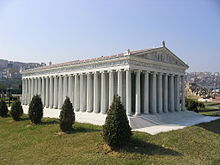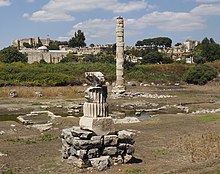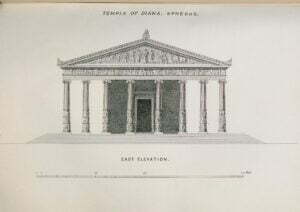Efes Artemis Tapınağı
Diana Tapınağı, Artemision olarak da bilinir.
- Tür: Tapınak
- Tema: Dünyanın Yedi Harikası, Yurt Dışına Çıkarılan Kültür Varlıkları
- Kültür: Antik Yunan, Lidya
- Yüzyıl: 2. yy, MÖ 4. yy, MÖ 6. yy
- Bölge: Türkiye, Ege Bölgesi, İzmir, Selçuk
- Durum: Yerinden Taşınmış



The Temple of Artemis or Artemision (Greek: Ἀρτεμίσιον; Turkish: Artemis Tapınağı), also known as the Temple of Diana, was a Greek temple dedicated to an ancient, localised form of the goddess Artemis (equalized to Diana, a Roman goddess). It was located in Ephesus (near the modern town of Selçuk in present-day Turkey). By AD 401 it had been ruined or destroyed.[1] Only foundations and fragments of the last temple remain at the site.
The earliest version of the temple (a Bronze Age temenos) antedated the Ionic immigration by many years. Callimachus, in his Hymn to Artemis, attributed it to the Amazons. In the 7th century BC, it was destroyed by a flood.
Its reconstruction, in more grandiose form, began around 550 BC, under Chersiphron, the Cretan architect, and his son Metagenes. The project was funded by Croesus of Lydia, and took 10 years to complete. This version of the temple was destroyed in 356 BC by an arsonist.
The next, greatest, and last form of the temple, funded by the Ephesians themselves, is described in Antipater of Sidon's list of the world's Seven Wonders:
I have set eyes on the wall of lofty Babylon on which is a road for chariots, and the statue of Zeus by the Alpheus, and the hanging gardens, and the colossus of the Sun, and the huge labour of the high pyramids, and the vast tomb of Mausolus; but when I saw the house of Artemis that mounted to the clouds, those other marvels lost their brilliancy, and I said, "Lo, apart from Olympus, the Sun never looked on aught so grand".[2]
- ^ John Freely, The Western Shores of Turkey: Discovering the Aegean and Mediterranean Coasts 2004, p. 148; Clive Foss, Ephesus after antiquity: a late antique, Byzantine, and Turkish city, Cambridge University Press, 1979, pp. 86–89 & footnote 83.
- ^ Antipater, Greek Anthology IX.58.















✶ İlgili Yerler